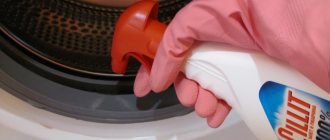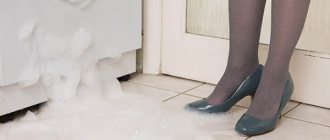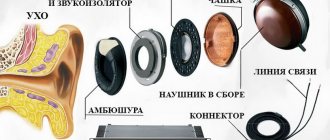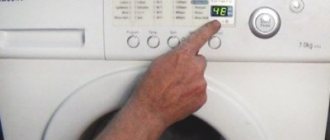It is difficult to imagine a residential or office space that does not have air conditioning. Just like in a refrigerator, the structure of which seems more understandable to us, in an air conditioning unit there is direct contact of warm air with a cold radiator (or evaporator, whichever is clearer to you). Dampness and drip formation inevitably occur in this place. During intensive work and high air temperatures, water literally flows from the air conditioner. Of course, the designers have provided for the possibility of removing excess moisture, but the owners of this useful device often observe water streaks on the wall. Why is this happening? Let's look at this problem in our review.
Why does water flow from the split system indoors?
There are many reasons why the indoor unit of an air conditioner leaks. In this article we will look at them one by one, from frequent and simple to more rare. This will make it easier for you to find the problem and fix it yourself.
Causes:
- The drainage tray is full;
- Broken pipe;
- The drainage tube is clogged;
- The drain tube is not installed correctly;
- Evaporator frozen;
- Problems with the pump;
- The freon line is broken.
What to do if your neighbor's air conditioner is leaking
In apartments of multi-storey buildings, there is often a problem of water draining from the air conditioner of neighbors living on the floor above, and falling onto the outdoor unit of the split system of the neighbors below. Drops can fall into the window, hit the window sill or outdoor unit, beating a “drum roll”.
In this case, you need to talk to your neighbors and ask them to turn the drainage pipe a little to the side. If neighbors refuse to help solve this problem, you can install a protective canopy for the outdoor unit of the split system.
Any malfunctions in the operation of climate control equipment cannot be ignored. If you notice a water leak from the air conditioner, have determined the cause of the problem, but cannot solve the problem yourself, be sure to contact a service center. Experienced specialists will quickly fix problems and resume normal operation of the split system. Timely repairs will eliminate more serious breakdowns, preventing premature failure of expensive equipment.
Sources:
- https://4shop.ru/news/potek-konditsioner-prichiny-sposoby-resheniya/
- https://samelectrik.ru/pochemu-kondicioner-kapaet-v-komnatu-i-chto-delat-v-etom-sluchae.html
- https://rembitteh.ru/hozyayke-na-zametku/techet-konditsioner/
- https://vsekondicioneri.ru/blog/pochemu-iz-konditsionera-techet-voda-kak-ustranit/
- https://vteple.xyz/pochemu-techet-voda-iz-kondicionera/
See also:
- How to install air conditioning on the balcony
- How to clean your air conditioner yourself
- How to hang an air conditioner correctly
- How to clean your home air conditioner
- How to install an air conditioner yourself
- Why does the air conditioner stink?
- How to drain an air conditioner into a sewer
- How to remove an air conditioner with your own hands
- Do-it-yourself split system installation
- Why is the air conditioner knocking?
- How does a ducted air conditioner work?
- Why doesn't the air conditioner turn on in my car?
- How to turn on the air conditioner for heating
- Why is the air conditioner humming?
- How to choose a split system for an apartment?
Dirt in the tray
Condensation accumulates in any indoor air conditioner unit. It falls into a special tray, from which it goes into a drainage tube. If moisture drips from the indoor unit, or the air conditioner generally spits water, the tray is most likely clogged.
Dust and dirt can get into the drain container, and if the split system is installed in the kitchen, grease. They gradually fill the spaces and there is no room left for water. If the air conditioner spits water, this is a sure sign that this is the cause.
Solution of the problem
You need to open the air conditioner cover and look at the condition of the tray. If there is a lot of dirt in it, take it out and clean it. Sometimes you will have to remove the front panel to do this, but this is not difficult - you will only need to unscrew a few screws.
If the tray cannot be reached (it is hidden behind a radiator or fan), then arm yourself with an old toothbrush and detergent. The main thing is to avoid dirt getting into the drain hole.
How to choose a model for a boiler?
If your water heater is equipped with a safety valve as standard, you must purchase the same model to replace it. However, sometimes situations arise when it is necessary to install the device on an old boiler model that is not equipped with such protection.
In such cases, it is customary to be guided by the color of the release handle:
- red color - the model is designed for a maximum pressure of 0.6 MPa;
- black color - 0.7 mPa;
- blue color - 0.8 mPa.
The boiler parameters can be found in the instructions. Sometimes the maximum pressure is indicated on a special plate or paper sticker mounted on the body of the device.
It is necessary to select a device in strict accordance with the upcoming load. If it is designed for less pressure, the water will constantly drain. If the valve rating is much higher than the operating value, the device will not operate if overloaded, creating a danger for the heater.
Broken or broken connections
There is usually a pipe between the drain hole of the tray and the drainage tube. Sometimes it can crack, break off or fly off the tubes. This is a flexible hose that is held on with clamps or latches.
Open the air conditioner cover and look on the right and left sides (depending on the installation option) at the condition of the pipe. If the problem is in it and it is from it that water flows, it needs to be changed.
Solution
Don't look for an original pipe - you'll just waste your money . At any plumbing store or market, buy one of the same diameter and secure it with ordinary plastic zip ties.
If the old pipe was secured with clamps, wrap them or the pipe itself with fum tape. Then put on a new one.
Air conditioner drain pipe in the indoor unit.
The air conditioner is leaking, recommendations
All of the above reasons are not the only ones, but are the most common in practice. To a large extent, everything depends on how well the drainage from the air conditioner was thought out and executed during its installation or laying of communications.
After completing the installation work, it is necessary to check how the drainage is proceeding. This is very simple to do, just fill a convenient container with water and carefully, without fanaticism, pour it directly onto the evaporator.
An equally important factor will be timely maintenance of the air conditioner, which should preferably be carried out at least once every 2-3 years.
Shall we clean the pipes?
Often the cause of condensation leaking from the air conditioner is a clogged drain pipe. This can be easily determined by eye.
Turn off the air conditioner and open the lid. If there is not a lot of dirt in the tray and the pipe is in good condition, the water should go down the drain. If there is water standing in the container, it means the drainage is clogged. You need to “break through” the resulting traffic jam.
Getting rid of the blockage
To clean the drain tube, disconnect it from the container. Just don’t forget to place a bucket or basin, otherwise all the water from the tray will be on the floor and walls... To clean the drainage, you need a regular electrical cable. It should be soft enough that it can be bent with little effort.
Insert the end of the cable into the drain tube and push into it until you feel it hit something. Congratulations, you've found the traffic jam! Now it needs to be broken through. To do this, “knock” on the plug until the cable goes further. But that is not all!
Most likely, you only made a small hole in the clog. Pull out the wire completely and wrap the end with cloth. It is advisable to secure it with tape or tape. Soak the cloth in detergent and clean the drain tube thoroughly.
Options for solving the problem
As soon as you notice that water has started to flow, immediately disconnect it from the power supply. You can clean the drainage tube yourself. To begin, take a medium-thick wire and make a small hook. Then carefully insert it into the drainage tube and push it forward with rotational movements.
From time to time, take it out and clean it. If you feel that the wire is resting against something, then the reason is a blockage. Thanks to the pre-formed hook, you can easily reach any midge. In addition, you should clean the condensate tank, bath, and filters from bacterial contamination using special products.
Professionally, I use steam cleaning, which will deal with bacteria and germs. Steam is supplied under pressure through a special pipe
If there is icing, you should wait until the ice melts on its own. Then contact the master. After such an express cleaning, you can also carry out a general cleaning.
To do this, you need to disassemble the indoor unit. Using a screwdriver, remove the drain pan, then attach a high-pressure washer (water hose) to the drain pipe and rinse for 5-10 minutes. If you find that the problem is due to unprofessional installation, then you should call specialists.
To prevent breakdowns, you should regularly carry out technical cleaning of the air conditioner, which consists of washing the filters and drain pipe. In warm weather, climate control equipment must be cleaned once every 2 weeks. From time to time you should check the condensation level of the split system.
An effective way to check the condition of the strainer is to spray it with a thin stream of clean water.
Now you know, if water flows into the apartment from the split system, you should immediately disconnect the device from the power supply. Then you need to check the condition of the air conditioner. And if, after all our recommendations, water is still dripping, then immediately call a specialist.
Installers with two left hands
Problems with condensate drainage may begin soon after installing the air conditioner. In 99% of cases this is due to unprofessional (in some cases drunk) installers.
The fact is that the drainage tube must slope downwards throughout its entire length. Sometimes, during installation, a hole is made in the wall that runs parallel to the ground, or even directed upwards. In this case, according to the law of gravity, moisture will not be able to flow out and will accumulate in the tray.
It is not difficult to identify the problem - just look at the places where the drainage enters and exits the wall.
Solution
There are two options - either punch a new hole, or hang the air conditioner higher. But the best thing is to call the installers. They simply must correct their mistake.
If you installed the air conditioner yourself, you will have to arm yourself with a hammer drill and choose. Naturally, it will be easier to punch a new hole. Its entrance should begin in the same place as the old one, but the channel should be directed downward.
Signs of malfunction
First, a little theory. An air conditioner is one of the types of climate control equipment. The equipment allows you to maintain a comfortable temperature level in the apartment in hot weather. However, its operation entails certain difficulties. It happens that liquid leaks directly into the room, and often this is not a couple of drops, but a rather impressive leak. Even more difficulties arise if the entire internal unit of the equipment leaks - then condensation flows onto the floor, as well as furniture and other items, including electrical appliances, which can result in complete failure of home appliances.
Let's try to figure out why water is dripping from the air conditioner. The fact is that the principle of operation of the equipment is not only to cool the air, but also to create a favorable microclimate in the room. For this purpose, the system is additionally equipped with the option of drying air flows. The mechanism of action is simple: liquid from the air, in contact with a cooled element, condenses and settles on the surface of the indoor unit, from where it is discharged to the external one. It is impossible to determine exactly how much water is produced per day. Much here depends on the initial air temperature and the level of its humidity, as well as on how many degrees the room needs to be cooled - that is, the determining factors in this case are the power of the equipment and the climate parameters in the room. On average, a split system is capable of removing 13-15 liters of water per day; industrial air conditioners with high power are capable of converting up to 150 liters of liquid in 24 hours.
Most of the models on the market remove moisture to the street, but if liquid suddenly stops flowing from the external unit, this directly indicates a malfunction of the equipment.
The presence of a breakdown is also indicated by the appearance of ice on the block. Regardless of whether entire drops freeze or only slight frost appears, you should immediately call the experts, as this indicates that the temperature regulators are not working properly.
Arctic cold in the indoor unit
Sometimes the reason that water flows from the air conditioner may be ice on the evaporator. Open the outer panel of the indoor unit of the air conditioner and inspect the radiator. If there is ice on it, the cause has been found.
In this case, there is so much ice on the air conditioner evaporator that it even froze the filter.
Ice may appear for three reasons:
- The air conditioner is set to operating temperature too low;
- The room temperature is lower than the operating temperature than the air conditioner and the humidity is high;
- There is not enough freon in the line.
Your actions
Turn off the air conditioner and wait until the evaporator thaws. To speed up the process, you can blow it with a regular hair dryer. After this, increase the temperature and use the device.
If the leak appears again over time, the problem is most likely low freon pressure. You won’t be able to fix this yourself, call a professional. At the same time make sure that the repairman has checked the freon line for leaks and topped up the air conditioner.
The fact is that the refrigerant circulation system is closed. If the pressure drops in it, then it could be broken. But sometimes freon comes out through microcracks in pipes or fittings very slowly and it doesn’t always make sense to seal them.
How does this valve work?
The boiler safety valve also functions as a check valve, which is reflected in its design. Schematically, the product can be represented as two thin-walled cylinders located at right angles to each other, having different sizes, and endowed with a common working cavity.
If you look inside a larger cylinder, you can see a check valve installed there, the design of which includes a plate, a spring and a seat machined into the body of the product. The thread on both sides of this part of the protective device allows it to be connected to the inlet pipe of the electric boiler.
Inside the smaller cylinder there is also a shut-off device, similar in design to the check valve described above, differing only in the presence of a stiffer spring.
Most models of safety valves have a function for adjusting the opening pressure, produced by changing the degree of compression of the spring. The drainage hole is located directly behind the locking mechanism. It is recommended to connect a transparent tube to this hole, which allows you to observe the water discharged from the tank.
View from three angles of the design of the safety valve used when connecting storage-type water heating equipment
The safety valve operates according to the following algorithm.
- When the tap mounted on the inlet line is open, water flows freely into the container through the hole created by pulling the check valve plate away from the seat. In this case, the incoming liquid does not have access to the drainage hole, because the safety spring has a rigidity designed for a higher pressure compared to the water supply value of this value.
- When the boiler is completely filled, the pressure level in the tank and in the main line is equalized, causing the check valve to close. An increase in the temperature of the heated water in the storage tank causes an increase in the pressure force on the check valve plate, which is pressed even tighter to the seat. Therefore, heated water can no longer return to the cold water supply pipes.
- When users begin to use hot water for domestic needs, the pressure inside the water heater begins to drop and reaches a value less than the tap value. At this moment, the plate is pressed away from the seat and the process of filling the tank with water begins.
- If the thermostat breaks down, an uncontrolled rise in temperature will begin, which will cause pressure to rise to a critical level. Here, as a result of compression of the safety valve spring, it will be possible for excess liquid to flow out through the drainage hole into the sewer system through a transparent hose.
A small lever is necessary to force the opening of the drainage hole, through which water is discharged and pressure is reduced
For exclusive owners
Sometimes water is drained using a special pump. This is usually done when it is not possible to lay drainage to the street. For example, if the room in which the air conditioner is installed is located below ground level - in the basement.
In this case, a small pump is placed on the drainage system, which pumps water out of it from time to time. Typical pump problems may include:
- The float chamber is clogged;
- The power contacts have come loose or oxidized;
- There is no contact between the sensor and the pump;
- The air vent tube is pinched, flown off or clogged;
- The pump itself burned out.
To find a solution to the problem, you need to check all the above points.
Freon evaporates in the wrong place
Inside the indoor unit there are copper tubes through which freon circulates. If a crack appears in them, it begins to evaporate. At the same time, its temperature can drop below -40 degrees.
At this temperature, moisture in the air crystallizes and settles on different parts of the indoor unit. Over time, it accumulates, heats up and begins to melt. In this case, drops of water fall past the tray and the air conditioner begins to flow.
It is difficult to determine this problem on your own, it is better not to risk it and call a specialist. If none of the solutions described helped you, contact a specialist. You can find it using a specialized service for selecting masters . He'll definitely figure it out.
Causes of leakage
- If the cooling system operates at full capacity for a long time - and this, as a rule, happens in hot summers - the condensate collection tank simply overflows, and that’s it, the device leaks into the house and not outside.
- In winter, the heat exchange part of the air conditioner may become covered with ice, and this in turn leads to the formation of condensation from the working fluid. It is he who begins to flow. Freezing occurs when the outside temperature differs significantly between day and night.
- The air conditioner drainage system may fail, causing condensate not to flow into a special container, but to drip or flow.
- The drainage hose may be in the wrong position, as a result of which the liquid simply does not rise in the right direction, and the split system begins to leak.
- The circuit has depressurized due to the fact that the pipes leading the liquid into the system have weakened, and it flows drop by drop.
- There may be excess fluid inside the circuit, which leads to increased pressure. This problem is quite serious, because in the end it may turn out that your air conditioner is not just leaking, but broken.
The flow of a split system looks like this:











